DMAIC Methodology Application to Natrel Milk Packaging Process
VerifiedAdded on 2023/05/31
|10
|1767
|401
Project
AI Summary
This project outlines the application of the DMAIC (Define, Measure, Analyze, Improve, Control) methodology to improve the packaging process of Natrel dark chocolate partly skimmed milk. The Define phase establishes the project charter, CTQ (Critical to Quality) factors, and toll gates for quality control. The 'As Is' process is mapped using SIPOC diagrams and swim lane process maps. The Measure phase identifies key metrics in the packaging process, including container counts, stock cycling, order fulfillment, and delivery. The Analyze phase identifies potential inefficiencies in each step, such as bottlenecks and idle time. The Improve phase suggests implementing NFC tags to enhance sorting during order fulfillment. Finally, the Control phase proposes guidelines for sustaining the improvements, including employee training and policy embedding, highlighting the importance of continuous monitoring and management support. Desklib provides access to similar projects and resources for students.
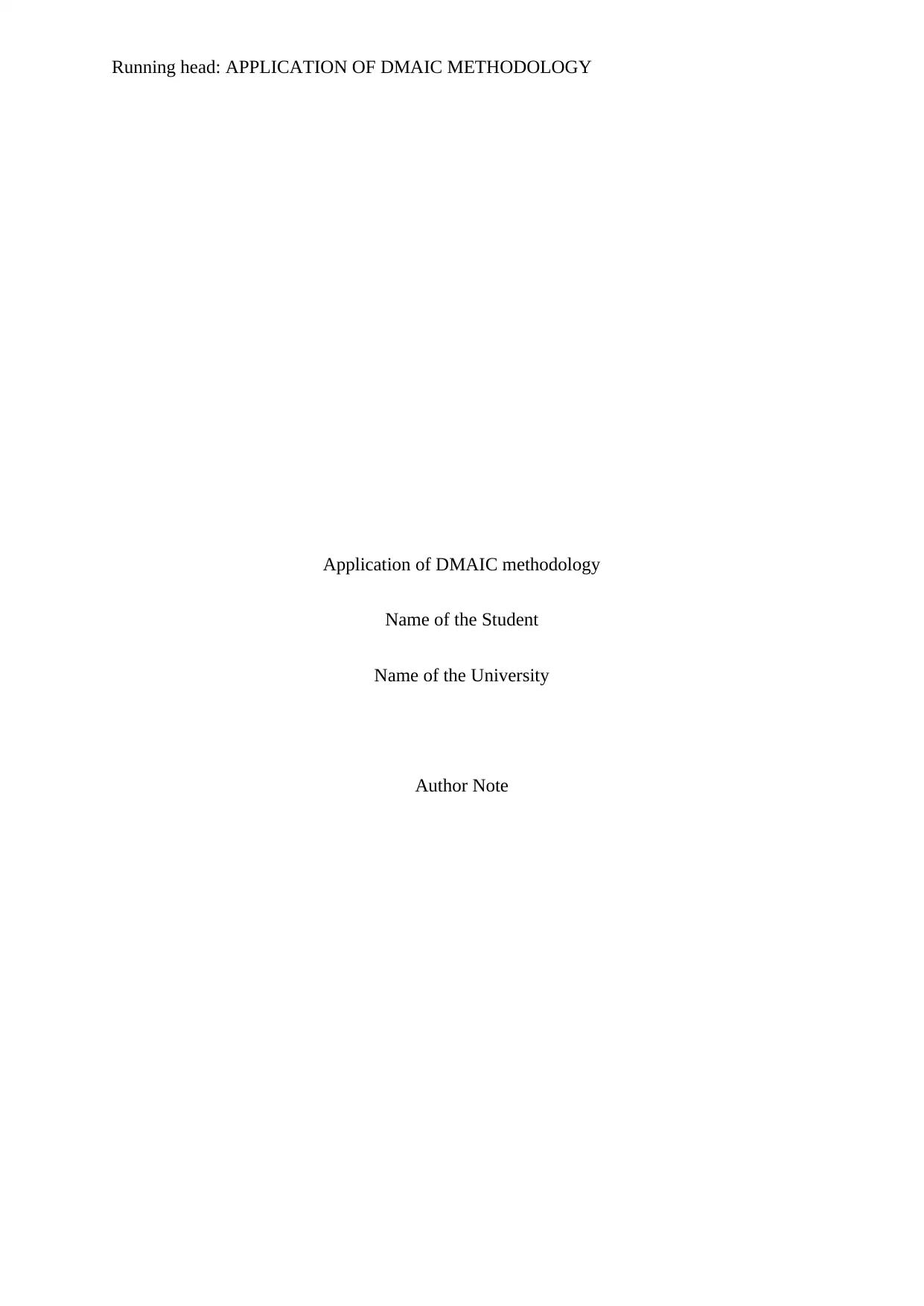
Running head: APPLICATION OF DMAIC METHODOLOGY
Application of DMAIC methodology
Name of the Student
Name of the University
Author Note
Application of DMAIC methodology
Name of the Student
Name of the University
Author Note
Secure Best Marks with AI Grader
Need help grading? Try our AI Grader for instant feedback on your assignments.
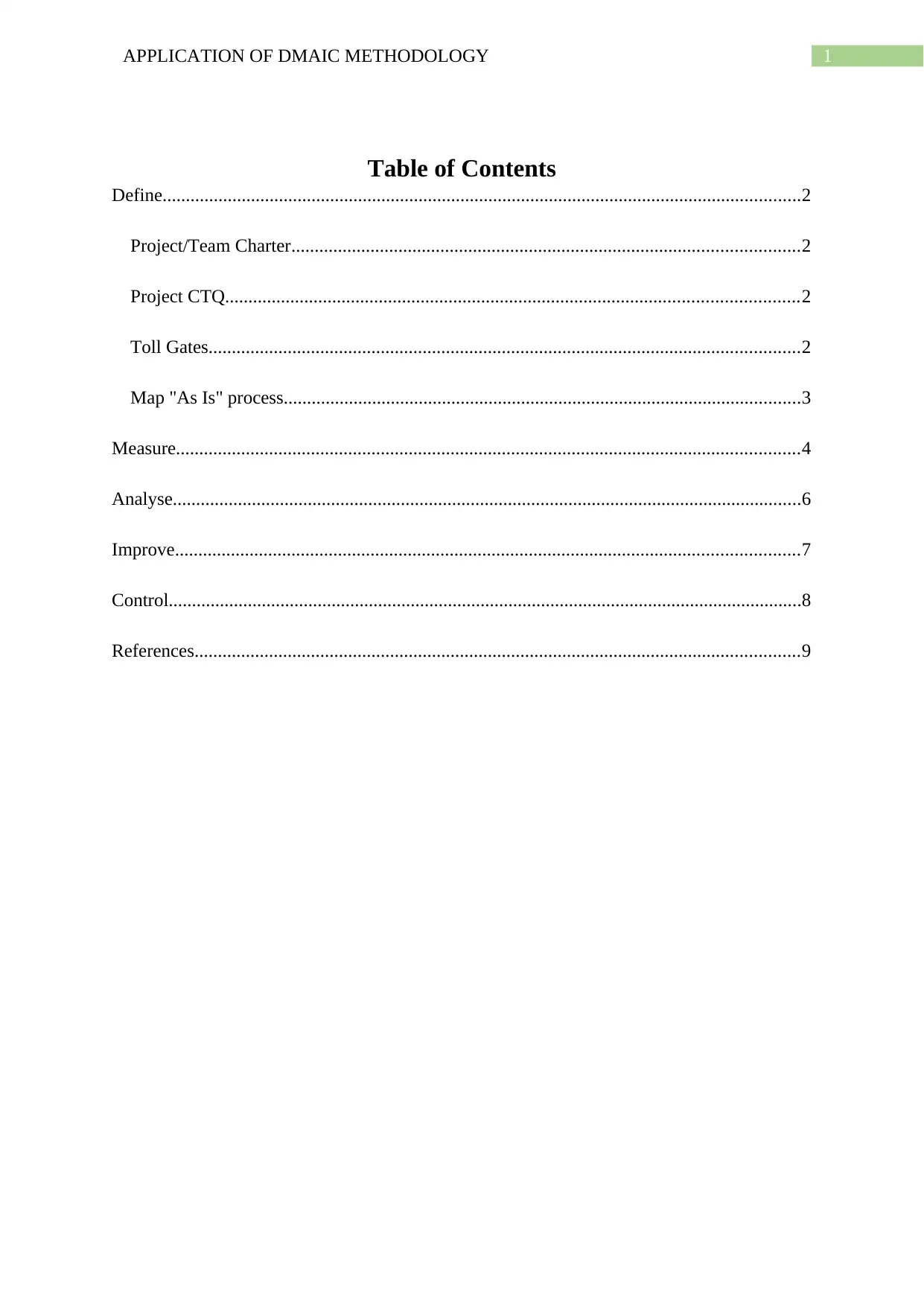
1APPLICATION OF DMAIC METHODOLOGY
Table of Contents
Define.........................................................................................................................................2
Project/Team Charter.............................................................................................................2
Project CTQ...........................................................................................................................2
Toll Gates...............................................................................................................................2
Map "As Is" process...............................................................................................................3
Measure......................................................................................................................................4
Analyse.......................................................................................................................................6
Improve......................................................................................................................................7
Control........................................................................................................................................8
References..................................................................................................................................9
Table of Contents
Define.........................................................................................................................................2
Project/Team Charter.............................................................................................................2
Project CTQ...........................................................................................................................2
Toll Gates...............................................................................................................................2
Map "As Is" process...............................................................................................................3
Measure......................................................................................................................................4
Analyse.......................................................................................................................................6
Improve......................................................................................................................................7
Control........................................................................................................................................8
References..................................................................................................................................9
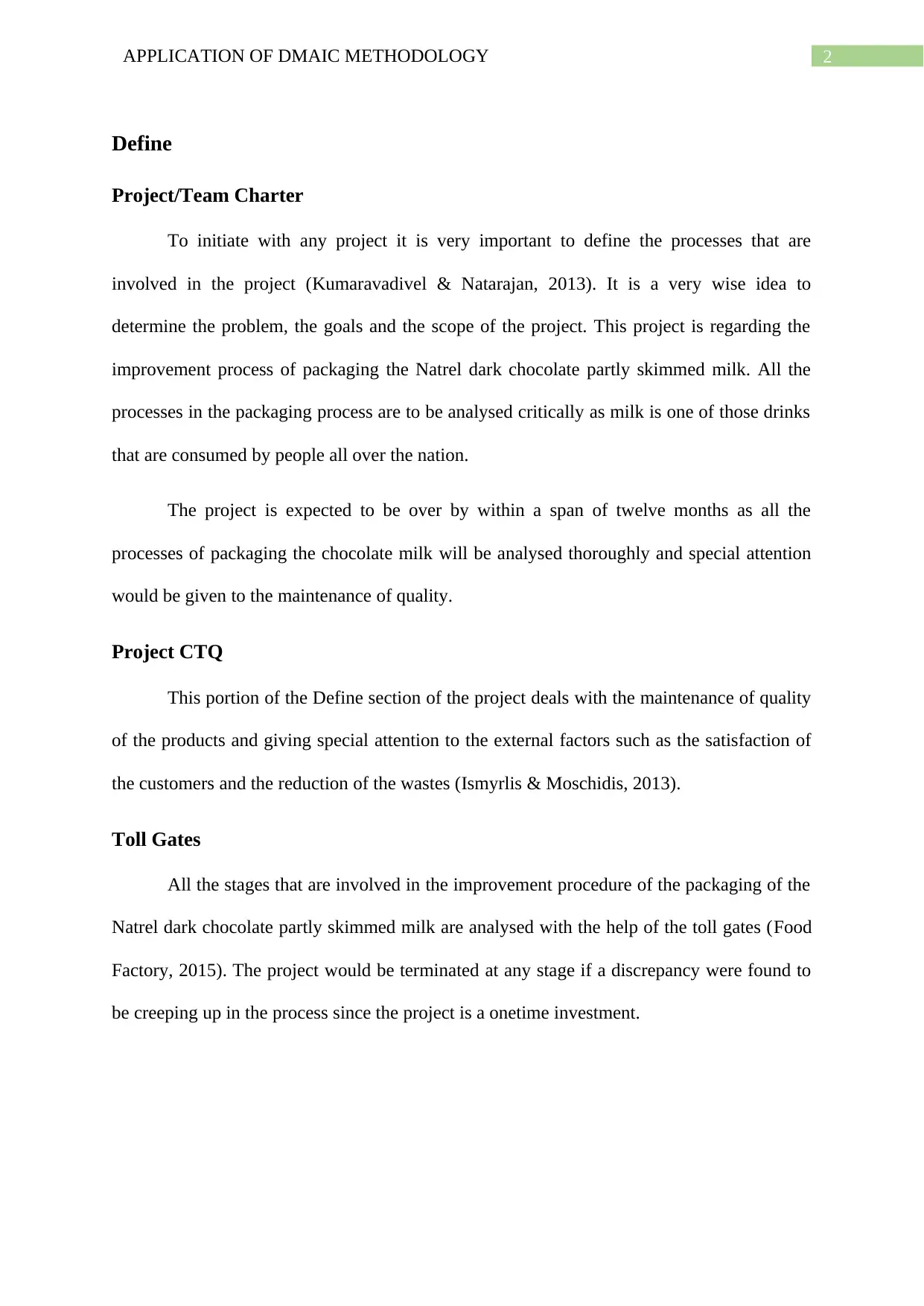
2APPLICATION OF DMAIC METHODOLOGY
Define
Project/Team Charter
To initiate with any project it is very important to define the processes that are
involved in the project (Kumaravadivel & Natarajan, 2013). It is a very wise idea to
determine the problem, the goals and the scope of the project. This project is regarding the
improvement process of packaging the Natrel dark chocolate partly skimmed milk. All the
processes in the packaging process are to be analysed critically as milk is one of those drinks
that are consumed by people all over the nation.
The project is expected to be over by within a span of twelve months as all the
processes of packaging the chocolate milk will be analysed thoroughly and special attention
would be given to the maintenance of quality.
Project CTQ
This portion of the Define section of the project deals with the maintenance of quality
of the products and giving special attention to the external factors such as the satisfaction of
the customers and the reduction of the wastes (Ismyrlis & Moschidis, 2013).
Toll Gates
All the stages that are involved in the improvement procedure of the packaging of the
Natrel dark chocolate partly skimmed milk are analysed with the help of the toll gates (Food
Factory, 2015). The project would be terminated at any stage if a discrepancy were found to
be creeping up in the process since the project is a onetime investment.
Define
Project/Team Charter
To initiate with any project it is very important to define the processes that are
involved in the project (Kumaravadivel & Natarajan, 2013). It is a very wise idea to
determine the problem, the goals and the scope of the project. This project is regarding the
improvement process of packaging the Natrel dark chocolate partly skimmed milk. All the
processes in the packaging process are to be analysed critically as milk is one of those drinks
that are consumed by people all over the nation.
The project is expected to be over by within a span of twelve months as all the
processes of packaging the chocolate milk will be analysed thoroughly and special attention
would be given to the maintenance of quality.
Project CTQ
This portion of the Define section of the project deals with the maintenance of quality
of the products and giving special attention to the external factors such as the satisfaction of
the customers and the reduction of the wastes (Ismyrlis & Moschidis, 2013).
Toll Gates
All the stages that are involved in the improvement procedure of the packaging of the
Natrel dark chocolate partly skimmed milk are analysed with the help of the toll gates (Food
Factory, 2015). The project would be terminated at any stage if a discrepancy were found to
be creeping up in the process since the project is a onetime investment.
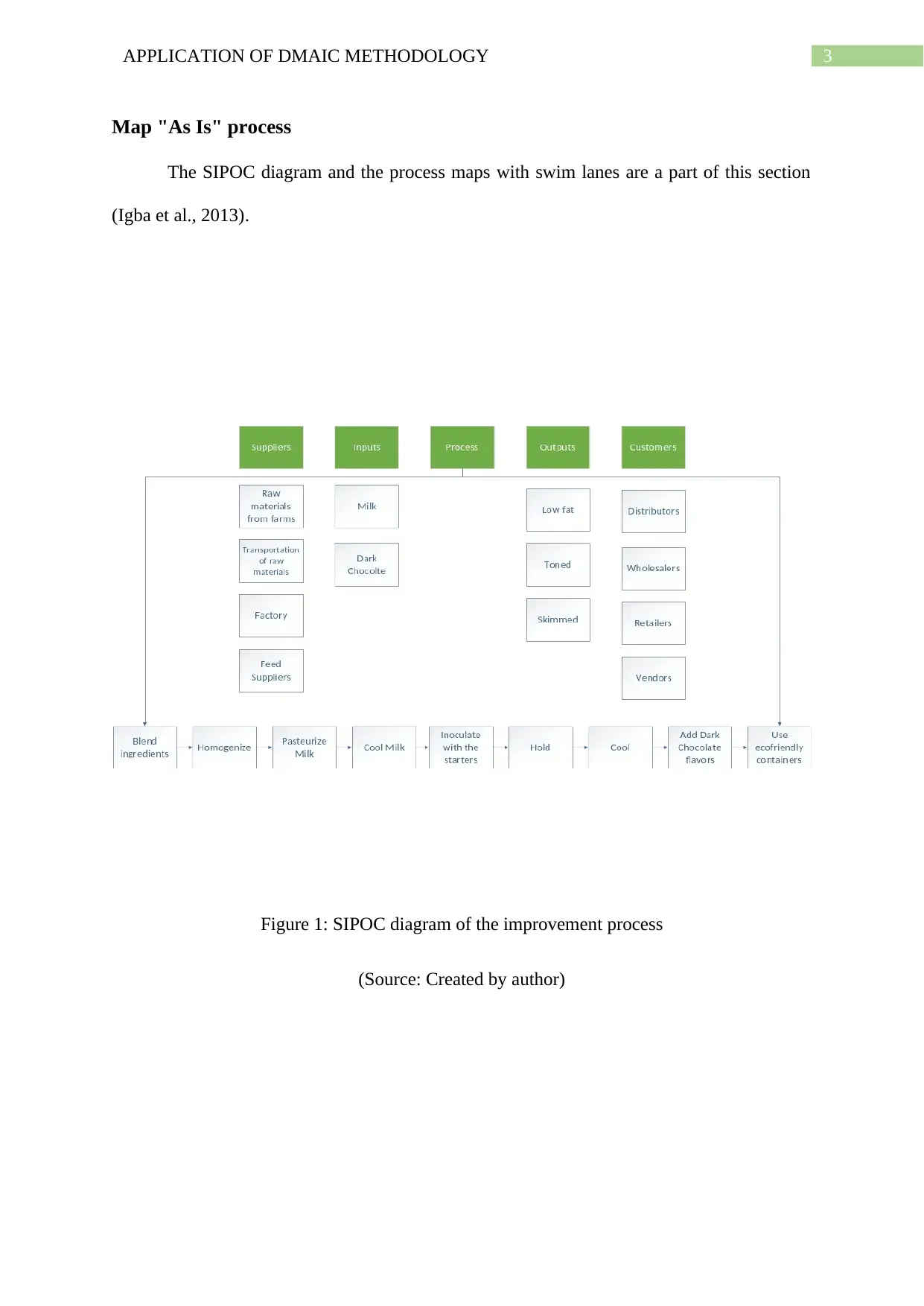
3APPLICATION OF DMAIC METHODOLOGY
Map "As Is" process
The SIPOC diagram and the process maps with swim lanes are a part of this section
(Igba et al., 2013).
Figure 1: SIPOC diagram of the improvement process
(Source: Created by author)
Map "As Is" process
The SIPOC diagram and the process maps with swim lanes are a part of this section
(Igba et al., 2013).
Figure 1: SIPOC diagram of the improvement process
(Source: Created by author)
Secure Best Marks with AI Grader
Need help grading? Try our AI Grader for instant feedback on your assignments.
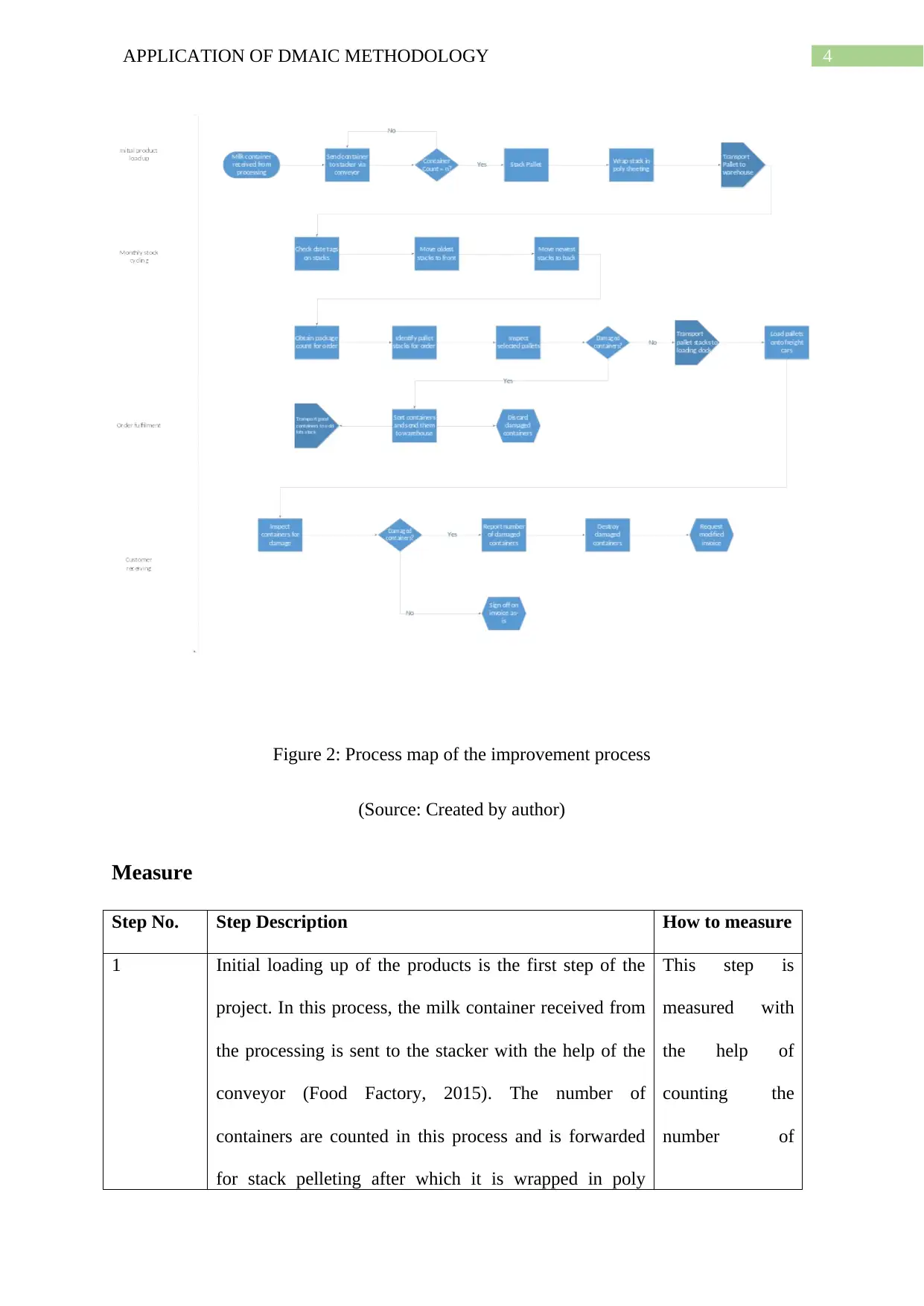
4APPLICATION OF DMAIC METHODOLOGY
Figure 2: Process map of the improvement process
(Source: Created by author)
Measure
Step No. Step Description How to measure
1 Initial loading up of the products is the first step of the
project. In this process, the milk container received from
the processing is sent to the stacker with the help of the
conveyor (Food Factory, 2015). The number of
containers are counted in this process and is forwarded
for stack pelleting after which it is wrapped in poly
This step is
measured with
the help of
counting the
number of
Figure 2: Process map of the improvement process
(Source: Created by author)
Measure
Step No. Step Description How to measure
1 Initial loading up of the products is the first step of the
project. In this process, the milk container received from
the processing is sent to the stacker with the help of the
conveyor (Food Factory, 2015). The number of
containers are counted in this process and is forwarded
for stack pelleting after which it is wrapped in poly
This step is
measured with
the help of
counting the
number of
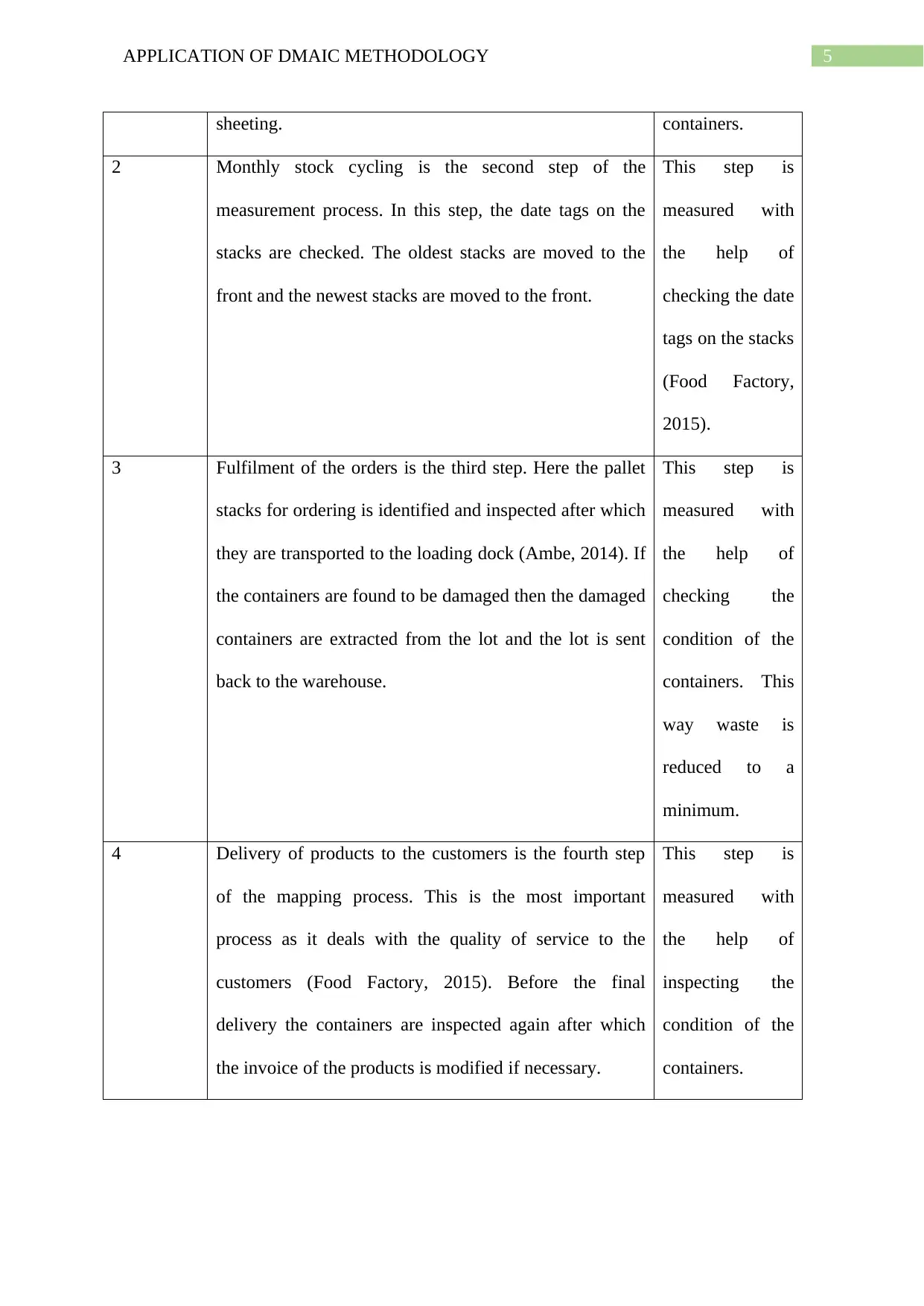
5APPLICATION OF DMAIC METHODOLOGY
sheeting. containers.
2 Monthly stock cycling is the second step of the
measurement process. In this step, the date tags on the
stacks are checked. The oldest stacks are moved to the
front and the newest stacks are moved to the front.
This step is
measured with
the help of
checking the date
tags on the stacks
(Food Factory,
2015).
3 Fulfilment of the orders is the third step. Here the pallet
stacks for ordering is identified and inspected after which
they are transported to the loading dock (Ambe, 2014). If
the containers are found to be damaged then the damaged
containers are extracted from the lot and the lot is sent
back to the warehouse.
This step is
measured with
the help of
checking the
condition of the
containers. This
way waste is
reduced to a
minimum.
4 Delivery of products to the customers is the fourth step
of the mapping process. This is the most important
process as it deals with the quality of service to the
customers (Food Factory, 2015). Before the final
delivery the containers are inspected again after which
the invoice of the products is modified if necessary.
This step is
measured with
the help of
inspecting the
condition of the
containers.
sheeting. containers.
2 Monthly stock cycling is the second step of the
measurement process. In this step, the date tags on the
stacks are checked. The oldest stacks are moved to the
front and the newest stacks are moved to the front.
This step is
measured with
the help of
checking the date
tags on the stacks
(Food Factory,
2015).
3 Fulfilment of the orders is the third step. Here the pallet
stacks for ordering is identified and inspected after which
they are transported to the loading dock (Ambe, 2014). If
the containers are found to be damaged then the damaged
containers are extracted from the lot and the lot is sent
back to the warehouse.
This step is
measured with
the help of
checking the
condition of the
containers. This
way waste is
reduced to a
minimum.
4 Delivery of products to the customers is the fourth step
of the mapping process. This is the most important
process as it deals with the quality of service to the
customers (Food Factory, 2015). Before the final
delivery the containers are inspected again after which
the invoice of the products is modified if necessary.
This step is
measured with
the help of
inspecting the
condition of the
containers.
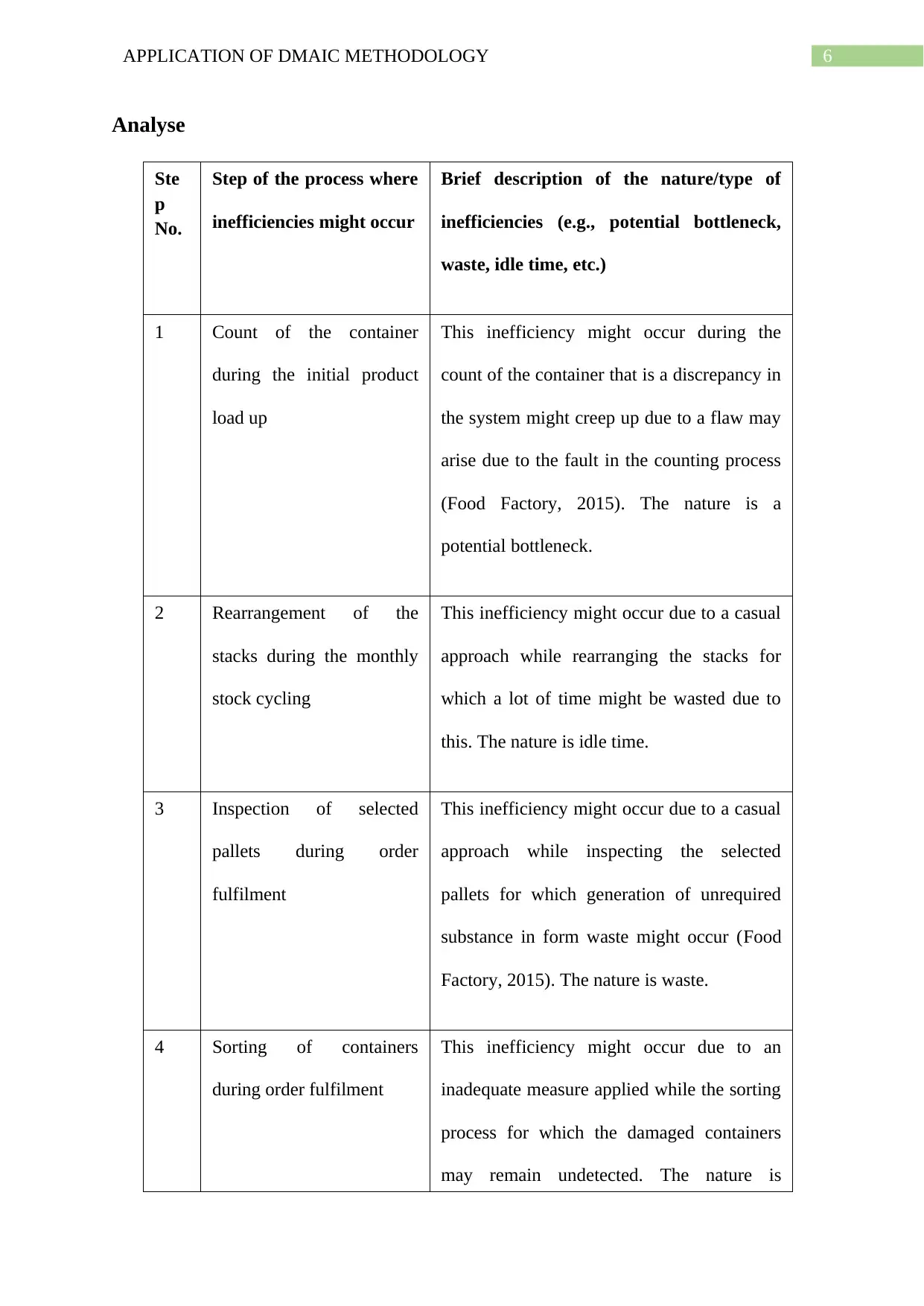
6APPLICATION OF DMAIC METHODOLOGY
Analyse
Ste
p
No.
Step of the process where
inefficiencies might occur
Brief description of the nature/type of
inefficiencies (e.g., potential bottleneck,
waste, idle time, etc.)
1 Count of the container
during the initial product
load up
This inefficiency might occur during the
count of the container that is a discrepancy in
the system might creep up due to a flaw may
arise due to the fault in the counting process
(Food Factory, 2015). The nature is a
potential bottleneck.
2 Rearrangement of the
stacks during the monthly
stock cycling
This inefficiency might occur due to a casual
approach while rearranging the stacks for
which a lot of time might be wasted due to
this. The nature is idle time.
3 Inspection of selected
pallets during order
fulfilment
This inefficiency might occur due to a casual
approach while inspecting the selected
pallets for which generation of unrequired
substance in form waste might occur (Food
Factory, 2015). The nature is waste.
4 Sorting of containers
during order fulfilment
This inefficiency might occur due to an
inadequate measure applied while the sorting
process for which the damaged containers
may remain undetected. The nature is
Analyse
Ste
p
No.
Step of the process where
inefficiencies might occur
Brief description of the nature/type of
inefficiencies (e.g., potential bottleneck,
waste, idle time, etc.)
1 Count of the container
during the initial product
load up
This inefficiency might occur during the
count of the container that is a discrepancy in
the system might creep up due to a flaw may
arise due to the fault in the counting process
(Food Factory, 2015). The nature is a
potential bottleneck.
2 Rearrangement of the
stacks during the monthly
stock cycling
This inefficiency might occur due to a casual
approach while rearranging the stacks for
which a lot of time might be wasted due to
this. The nature is idle time.
3 Inspection of selected
pallets during order
fulfilment
This inefficiency might occur due to a casual
approach while inspecting the selected
pallets for which generation of unrequired
substance in form waste might occur (Food
Factory, 2015). The nature is waste.
4 Sorting of containers
during order fulfilment
This inefficiency might occur due to an
inadequate measure applied while the sorting
process for which the damaged containers
may remain undetected. The nature is
Paraphrase This Document
Need a fresh take? Get an instant paraphrase of this document with our AI Paraphraser
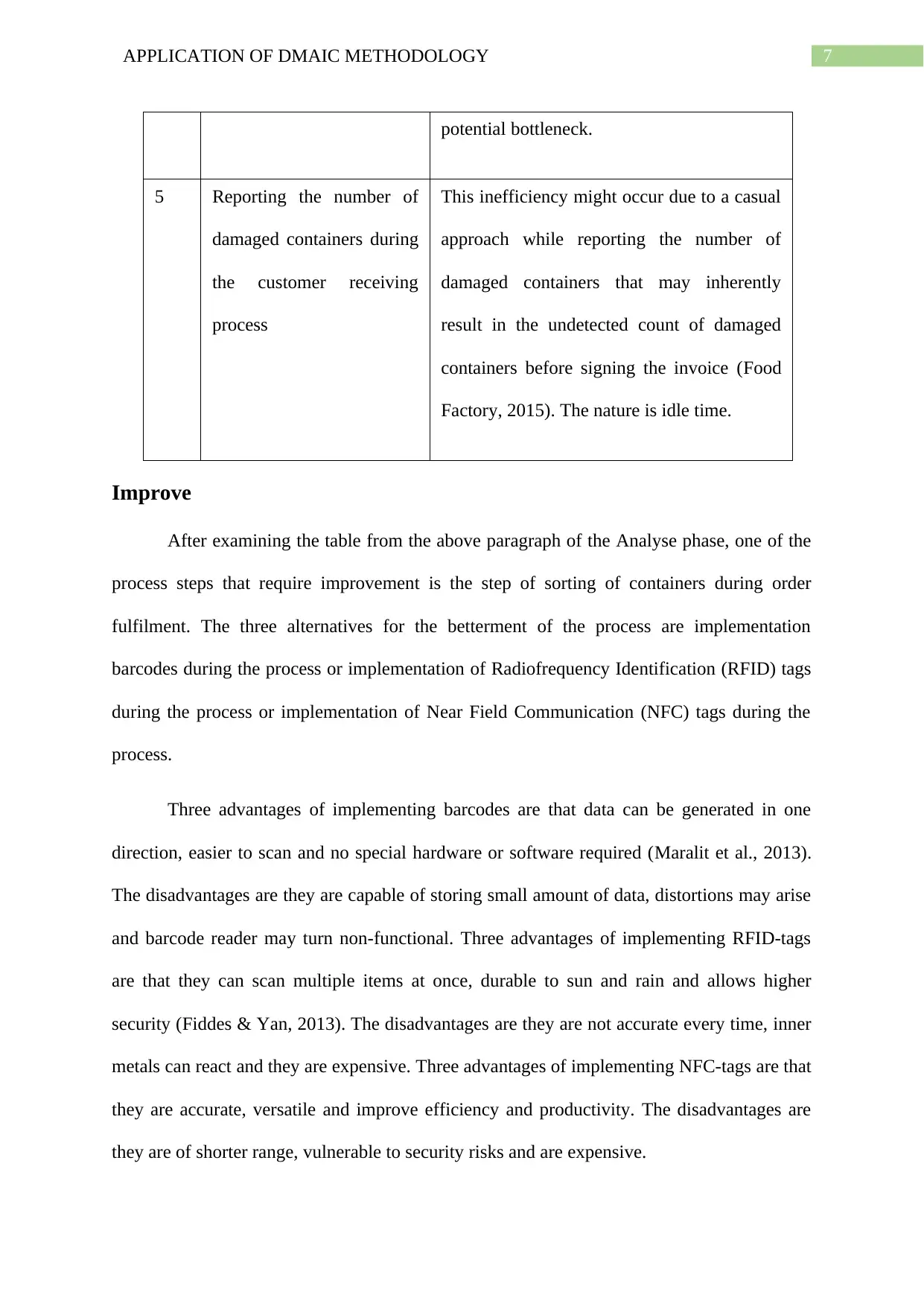
7APPLICATION OF DMAIC METHODOLOGY
potential bottleneck.
5 Reporting the number of
damaged containers during
the customer receiving
process
This inefficiency might occur due to a casual
approach while reporting the number of
damaged containers that may inherently
result in the undetected count of damaged
containers before signing the invoice (Food
Factory, 2015). The nature is idle time.
Improve
After examining the table from the above paragraph of the Analyse phase, one of the
process steps that require improvement is the step of sorting of containers during order
fulfilment. The three alternatives for the betterment of the process are implementation
barcodes during the process or implementation of Radiofrequency Identification (RFID) tags
during the process or implementation of Near Field Communication (NFC) tags during the
process.
Three advantages of implementing barcodes are that data can be generated in one
direction, easier to scan and no special hardware or software required (Maralit et al., 2013).
The disadvantages are they are capable of storing small amount of data, distortions may arise
and barcode reader may turn non-functional. Three advantages of implementing RFID-tags
are that they can scan multiple items at once, durable to sun and rain and allows higher
security (Fiddes & Yan, 2013). The disadvantages are they are not accurate every time, inner
metals can react and they are expensive. Three advantages of implementing NFC-tags are that
they are accurate, versatile and improve efficiency and productivity. The disadvantages are
they are of shorter range, vulnerable to security risks and are expensive.
potential bottleneck.
5 Reporting the number of
damaged containers during
the customer receiving
process
This inefficiency might occur due to a casual
approach while reporting the number of
damaged containers that may inherently
result in the undetected count of damaged
containers before signing the invoice (Food
Factory, 2015). The nature is idle time.
Improve
After examining the table from the above paragraph of the Analyse phase, one of the
process steps that require improvement is the step of sorting of containers during order
fulfilment. The three alternatives for the betterment of the process are implementation
barcodes during the process or implementation of Radiofrequency Identification (RFID) tags
during the process or implementation of Near Field Communication (NFC) tags during the
process.
Three advantages of implementing barcodes are that data can be generated in one
direction, easier to scan and no special hardware or software required (Maralit et al., 2013).
The disadvantages are they are capable of storing small amount of data, distortions may arise
and barcode reader may turn non-functional. Three advantages of implementing RFID-tags
are that they can scan multiple items at once, durable to sun and rain and allows higher
security (Fiddes & Yan, 2013). The disadvantages are they are not accurate every time, inner
metals can react and they are expensive. Three advantages of implementing NFC-tags are that
they are accurate, versatile and improve efficiency and productivity. The disadvantages are
they are of shorter range, vulnerable to security risks and are expensive.
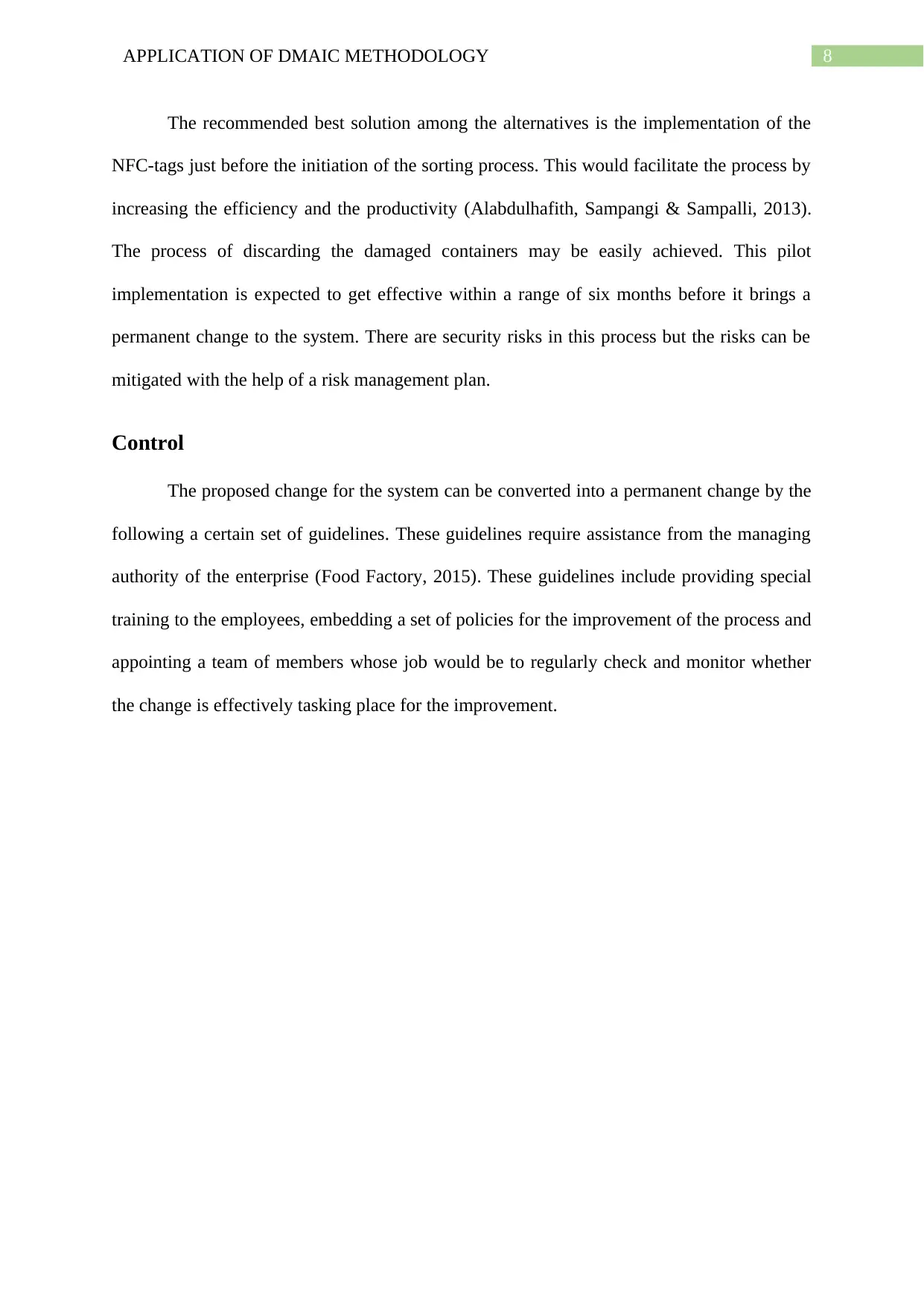
8APPLICATION OF DMAIC METHODOLOGY
The recommended best solution among the alternatives is the implementation of the
NFC-tags just before the initiation of the sorting process. This would facilitate the process by
increasing the efficiency and the productivity (Alabdulhafith, Sampangi & Sampalli, 2013).
The process of discarding the damaged containers may be easily achieved. This pilot
implementation is expected to get effective within a range of six months before it brings a
permanent change to the system. There are security risks in this process but the risks can be
mitigated with the help of a risk management plan.
Control
The proposed change for the system can be converted into a permanent change by the
following a certain set of guidelines. These guidelines require assistance from the managing
authority of the enterprise (Food Factory, 2015). These guidelines include providing special
training to the employees, embedding a set of policies for the improvement of the process and
appointing a team of members whose job would be to regularly check and monitor whether
the change is effectively tasking place for the improvement.
The recommended best solution among the alternatives is the implementation of the
NFC-tags just before the initiation of the sorting process. This would facilitate the process by
increasing the efficiency and the productivity (Alabdulhafith, Sampangi & Sampalli, 2013).
The process of discarding the damaged containers may be easily achieved. This pilot
implementation is expected to get effective within a range of six months before it brings a
permanent change to the system. There are security risks in this process but the risks can be
mitigated with the help of a risk management plan.
Control
The proposed change for the system can be converted into a permanent change by the
following a certain set of guidelines. These guidelines require assistance from the managing
authority of the enterprise (Food Factory, 2015). These guidelines include providing special
training to the employees, embedding a set of policies for the improvement of the process and
appointing a team of members whose job would be to regularly check and monitor whether
the change is effectively tasking place for the improvement.
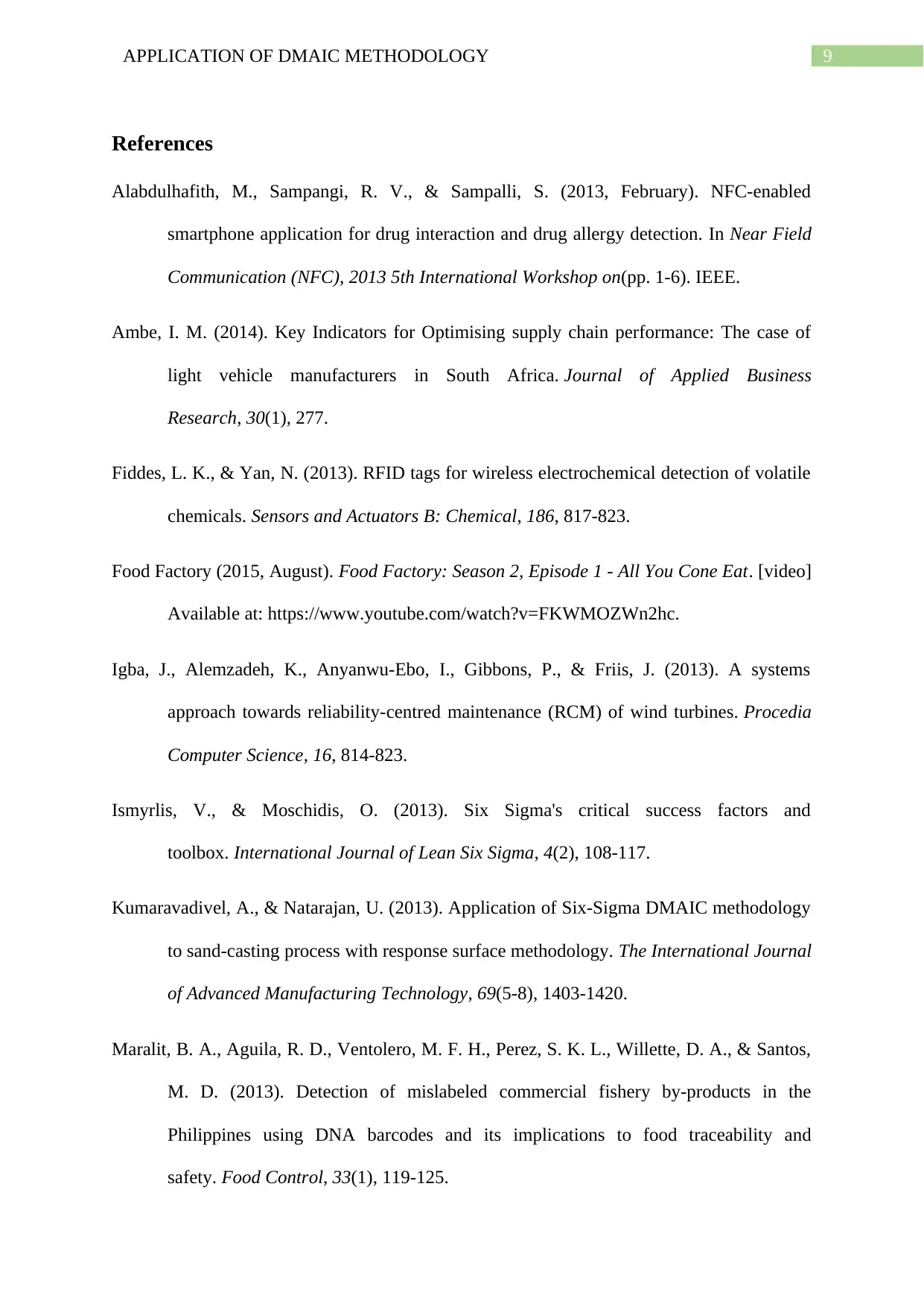
9APPLICATION OF DMAIC METHODOLOGY
References
Alabdulhafith, M., Sampangi, R. V., & Sampalli, S. (2013, February). NFC-enabled
smartphone application for drug interaction and drug allergy detection. In Near Field
Communication (NFC), 2013 5th International Workshop on(pp. 1-6). IEEE.
Ambe, I. M. (2014). Key Indicators for Optimising supply chain performance: The case of
light vehicle manufacturers in South Africa. Journal of Applied Business
Research, 30(1), 277.
Fiddes, L. K., & Yan, N. (2013). RFID tags for wireless electrochemical detection of volatile
chemicals. Sensors and Actuators B: Chemical, 186, 817-823.
Food Factory (2015, August). Food Factory: Season 2, Episode 1 - All You Cone Eat. [video]
Available at: https://www.youtube.com/watch?v=FKWMOZWn2hc.
Igba, J., Alemzadeh, K., Anyanwu-Ebo, I., Gibbons, P., & Friis, J. (2013). A systems
approach towards reliability-centred maintenance (RCM) of wind turbines. Procedia
Computer Science, 16, 814-823.
Ismyrlis, V., & Moschidis, O. (2013). Six Sigma's critical success factors and
toolbox. International Journal of Lean Six Sigma, 4(2), 108-117.
Kumaravadivel, A., & Natarajan, U. (2013). Application of Six-Sigma DMAIC methodology
to sand-casting process with response surface methodology. The International Journal
of Advanced Manufacturing Technology, 69(5-8), 1403-1420.
Maralit, B. A., Aguila, R. D., Ventolero, M. F. H., Perez, S. K. L., Willette, D. A., & Santos,
M. D. (2013). Detection of mislabeled commercial fishery by-products in the
Philippines using DNA barcodes and its implications to food traceability and
safety. Food Control, 33(1), 119-125.
References
Alabdulhafith, M., Sampangi, R. V., & Sampalli, S. (2013, February). NFC-enabled
smartphone application for drug interaction and drug allergy detection. In Near Field
Communication (NFC), 2013 5th International Workshop on(pp. 1-6). IEEE.
Ambe, I. M. (2014). Key Indicators for Optimising supply chain performance: The case of
light vehicle manufacturers in South Africa. Journal of Applied Business
Research, 30(1), 277.
Fiddes, L. K., & Yan, N. (2013). RFID tags for wireless electrochemical detection of volatile
chemicals. Sensors and Actuators B: Chemical, 186, 817-823.
Food Factory (2015, August). Food Factory: Season 2, Episode 1 - All You Cone Eat. [video]
Available at: https://www.youtube.com/watch?v=FKWMOZWn2hc.
Igba, J., Alemzadeh, K., Anyanwu-Ebo, I., Gibbons, P., & Friis, J. (2013). A systems
approach towards reliability-centred maintenance (RCM) of wind turbines. Procedia
Computer Science, 16, 814-823.
Ismyrlis, V., & Moschidis, O. (2013). Six Sigma's critical success factors and
toolbox. International Journal of Lean Six Sigma, 4(2), 108-117.
Kumaravadivel, A., & Natarajan, U. (2013). Application of Six-Sigma DMAIC methodology
to sand-casting process with response surface methodology. The International Journal
of Advanced Manufacturing Technology, 69(5-8), 1403-1420.
Maralit, B. A., Aguila, R. D., Ventolero, M. F. H., Perez, S. K. L., Willette, D. A., & Santos,
M. D. (2013). Detection of mislabeled commercial fishery by-products in the
Philippines using DNA barcodes and its implications to food traceability and
safety. Food Control, 33(1), 119-125.
1 out of 10
Your All-in-One AI-Powered Toolkit for Academic Success.
+13062052269
info@desklib.com
Available 24*7 on WhatsApp / Email
![[object Object]](/_next/static/media/star-bottom.7253800d.svg)
Unlock your academic potential
© 2024 | Zucol Services PVT LTD | All rights reserved.

